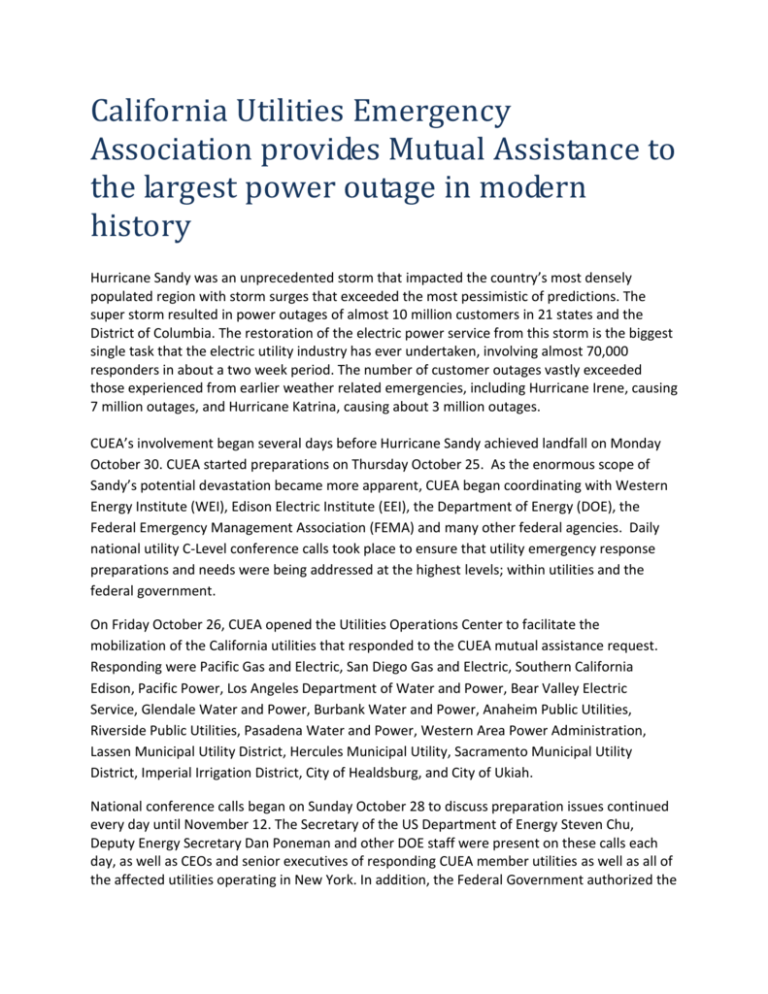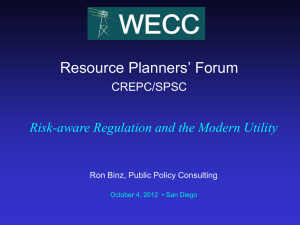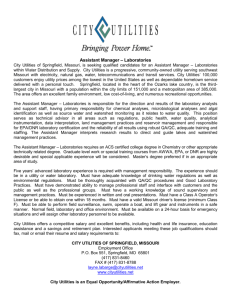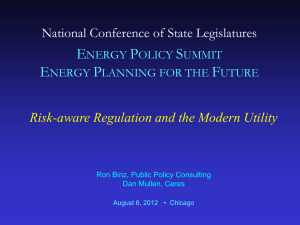California Utilities Emergency Association provides Mutual
advertisement

California Utilities Emergency Association provides Mutual Assistance to the largest power outage in modern history Hurricane Sandy was an unprecedented storm that impacted the country’s most densely populated region with storm surges that exceeded the most pessimistic of predictions. The super storm resulted in power outages of almost 10 million customers in 21 states and the District of Columbia. The restoration of the electric power service from this storm is the biggest single task that the electric utility industry has ever undertaken, involving almost 70,000 responders in about a two week period. The number of customer outages vastly exceeded those experienced from earlier weather related emergencies, including Hurricane Irene, causing 7 million outages, and Hurricane Katrina, causing about 3 million outages. CUEA’s involvement began several days before Hurricane Sandy achieved landfall on Monday October 30. CUEA started preparations on Thursday October 25. As the enormous scope of Sandy’s potential devastation became more apparent, CUEA began coordinating with Western Energy Institute (WEI), Edison Electric Institute (EEI), the Department of Energy (DOE), the Federal Emergency Management Association (FEMA) and many other federal agencies. Daily national utility C-Level conference calls took place to ensure that utility emergency response preparations and needs were being addressed at the highest levels; within utilities and the federal government. On Friday October 26, CUEA opened the Utilities Operations Center to facilitate the mobilization of the California utilities that responded to the CUEA mutual assistance request. Responding were Pacific Gas and Electric, San Diego Gas and Electric, Southern California Edison, Pacific Power, Los Angeles Department of Water and Power, Bear Valley Electric Service, Glendale Water and Power, Burbank Water and Power, Anaheim Public Utilities, Riverside Public Utilities, Pasadena Water and Power, Western Area Power Administration, Lassen Municipal Utility District, Hercules Municipal Utility, Sacramento Municipal Utility District, Imperial Irrigation District, City of Healdsburg, and City of Ukiah. National conference calls began on Sunday October 28 to discuss preparation issues continued every day until November 12. The Secretary of the US Department of Energy Steven Chu, Deputy Energy Secretary Dan Poneman and other DOE staff were present on these calls each day, as well as CEOs and senior executives of responding CUEA member utilities as well as all of the affected utilities operating in New York. In addition, the Federal Government authorized the placement of an EEI and other utility representatives in the FEMA National Response Coordination Center. The EEI representative working with WEI and CUEA helped facilitate and coordinate federal support for utilities, including those in New York, throughout this period. On Monday, October 29, Super Storm Sandy achieved landfall. California Emergency Management Agency Secretary, Mark Ghilarducci stood up a State Transportation Task Force staffed by Cal EMA, Caltrans, CHP, DOT, GIS and California State Warning Center representatives to directly support CUEA’s Utilities Operations Center. This Task Force assisted with permits, law assistance, scales and tacking of all ground units traveling from California to the east coast. After landfall, on each call, the CEOs and senior executives of the affected New York utilities articulated the estimated extent of their outages and damages as well as the estimated resources needed to expedite their restoration and recovery. They clearly indicated their needs for additional crews and other resources on a daily basis. The initial calls included reports from utilities from a very large number of states that had seen extensive damage. As utilities in other regions (such as the South, Mid‐Atlantic and Mid‐West) completed service recovery for their own customers, they were quickly redeployed to make resources available for the other utilities restoration. President Obama, Secretary Chu and FEMA Administrator, Craig Fugate, participated in the October 30 call from the White House Situation Room. The President expressed his intent to “eliminate any bureaucratic roadblocks” to the power restoration effort and commended the “dangerous and exhausting work being undertaken by the linemen and utility workers on the front lines.” The President also authorized US Air Force assets to be used for the transportation of the Western states utility equipment and personal to expedite response to Sandy’s devastation. CUEA utilities immediately shifted from overland transport to staging and deploying assets from Travis AFB and March AFB; eliminating several days of travel in getting to the stricken areas. Soon after Monday’s landfall in New York and New Jersey, based on damage reports, it quickly became apparent that there was a need for an unprecedented number of utility responders and that there would be an immediate need to bring in additional help from all over the country. EEI worked with WEI, CUEA and many utilities from the west coast, Rocky Mountain areas and far Mid‐West to obtain emergency response crews, trucks and other resources, working to expedite their transportation to the affected areas. Utilities throughout the Nation and Canada responded. The federal government was instrumental in helping transport some of these crews and equipment and in minimizing potential bureaucratic impediments to efficient transport of crews and trucks. The scope of executive level discussions exemplified the industry’s commitment to helping restore power for all affected communities. It is essential to recognize that in many cases, restoration activities could not even begin until fallen trees, water, sand, debris and snow (in West Virginia and later, New York and New England) were cleared from roads and water was pumped out of substations, underground networks and subways. Despite pre‐storm planning, new arrangements needed to be made to house, feed and provide supplies for utility workers, including those from CUEA utilities, because many more emergency assistance workers were needed than had initially been anticipated. As the recovery process extended into the second week, additional issues began to emerge, such as fuel availability. Utilities and federal representatives discussed both restoration of electric service to gasoline stations as well as fuel needs for utility responders. By the end of the response period, the focus was almost exclusively on the needs of New York and New Jersey utilities, as they had incurred the most extensive outages and damages. Coordination of the release and the assignment of utility resources were made on a daily basis, often several times a day amongst the voluntary utility Regional Mutual Assistance Groups (RMAGs). In addition, many agreements and protocols, including CUEA’s mutual assistance agreement which addresses basic payment, safety, liability and similar issues during emergency response activities, were already in place to facilitate this voluntary mutual assistance effort. As with any effort of this magnitude, the industry looks to find lessons learned to perform better the next time. CUEA is currently engaged in such an effort, and is coordinating with our federal and state partners as well. The utility industry’s voluntary commitment to assist each other in such devastating emergencies is unique in American industry. This reflects a deep belief in the essential nature of our service and the importance of providing reliable service at reasonable costs. CUEA is extremely proud of this voluntary mutual assistance tradition and of the long, hard work our California crew’s do, often under extremely difficult conditions, to help restore electric service in emergencies, such as that caused by Hurricane Sandy.




